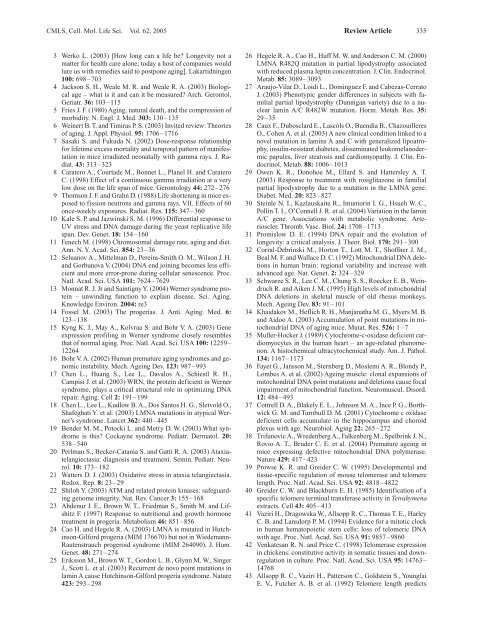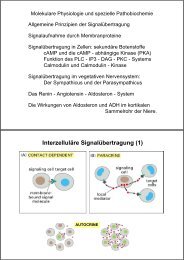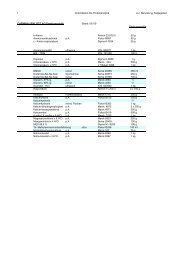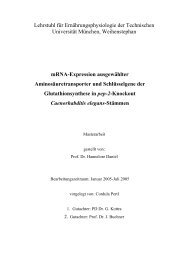Review The role of insulin and IGF-1 signaling in longevity
Review The role of insulin and IGF-1 signaling in longevity
Review The role of insulin and IGF-1 signaling in longevity
Create successful ePaper yourself
Turn your PDF publications into a flip-book with our unique Google optimized e-Paper software.
CMLS, Cell. Mol. Life Sci. Vol. 62, 2005 <strong>Review</strong> Article 335<br />
3 Werko L. (2003) [How long can a life be? Longevity not a<br />
matter for health care alone; today a host <strong>of</strong> companies would<br />
lure us with remedies said to postpone ag<strong>in</strong>g]. Lakartidn<strong>in</strong>gen<br />
100: 698–703<br />
4 Jackson S. H., Weale M. R. <strong>and</strong> Weale R. A. (2003) Biological<br />
age – what is it <strong>and</strong> can it be measured? Arch. Gerontol.<br />
Geriatr. 36: 103–115<br />
5 Fries J. F. (1980) Ag<strong>in</strong>g, natural death, <strong>and</strong> the compression <strong>of</strong><br />
morbidity. N. Engl. J. Med. 303: 130–135<br />
6 We<strong>in</strong>ert B. T. <strong>and</strong> Timiras P. S. (2003) Invited review: <strong>The</strong>ories<br />
<strong>of</strong> ag<strong>in</strong>g. J. Appl. Physiol. 95: 1706–1716<br />
7 Sasaki S. <strong>and</strong> Fukuda N. (2002) Dose-response relationship<br />
for lifetime excess mortality <strong>and</strong> temporal pattern <strong>of</strong> manifestation<br />
<strong>in</strong> mice irradiated neonatally with gamma rays. J. Radiat.<br />
43: 313–323<br />
8 Caratero A., Courtade M., Bonnet L., Planel H. <strong>and</strong> Caratero<br />
C. (1998) Effect <strong>of</strong> a cont<strong>in</strong>uous gamma irradiation at a very<br />
low dose on the life span <strong>of</strong> mice. Gerontology 44: 272–276<br />
9 Thomson J. F. <strong>and</strong> Grahn D. (1988) Life shorten<strong>in</strong>g <strong>in</strong> mice exposed<br />
to fission neutrons <strong>and</strong> gamma rays. VII. Effects <strong>of</strong> 60<br />
once-weekly exposures. Radiat. Res. 115: 347–360<br />
10 Kale S. P. <strong>and</strong> Jazw<strong>in</strong>ski S. M. (1996) Differential response to<br />
UV stress <strong>and</strong> DNA damage dur<strong>in</strong>g the yeast replicative life<br />
span. Dev. Genet. 18: 154–160<br />
11 Fenech M. (1998) Chromosomal damage rate, ag<strong>in</strong>g <strong>and</strong> diet.<br />
Ann. N. Y. Acad. Sci. 854: 23–36<br />
12 Seluanov A., Mittelman D., Pereira-Smith O. M., Wilson J. H.<br />
<strong>and</strong> Gorbunova V. (2004) DNA end jo<strong>in</strong><strong>in</strong>g becomes less efficient<br />
<strong>and</strong> more error-prone dur<strong>in</strong>g cellular senescence. Proc.<br />
Natl. Acad. Sci. USA 101: 7624–7629<br />
13 Monnat R. J. Jr <strong>and</strong> Sa<strong>in</strong>tigny Y. (2004) Werner syndrome prote<strong>in</strong><br />
– unw<strong>in</strong>d<strong>in</strong>g function to expla<strong>in</strong> disease. Sci. Ag<strong>in</strong>g.<br />
Knowledge Environ. 2004: re3<br />
14 Fossel M. (2003) <strong>The</strong> progerias. J. Anti. Ag<strong>in</strong>g. Med. 6:<br />
123–138<br />
15 Kyng K. J., May A., Kolvraa S. <strong>and</strong> Bohr V. A. (2003) Gene<br />
expression pr<strong>of</strong>il<strong>in</strong>g <strong>in</strong> Werner syndrome closely resembles<br />
that <strong>of</strong> normal ag<strong>in</strong>g. Proc. Natl. Acad. Sci. USA 100: 12259–<br />
12264<br />
16 Bohr V. A. (2002) Human premature ag<strong>in</strong>g syndromes <strong>and</strong> genomic<br />
<strong>in</strong>stability. Mech. Age<strong>in</strong>g Dev. 123: 987–993<br />
17 Chen L., Huang S., Lee L., Davalos A., Schiestl R. H.,<br />
Campisi J. et al. (2003) WRN, the prote<strong>in</strong> deficient <strong>in</strong> Werner<br />
syndrome, plays a critical structural <strong>role</strong> <strong>in</strong> optimiz<strong>in</strong>g DNA<br />
repair. Ag<strong>in</strong>g. Cell 2: 191–199<br />
18 Chen L., Lee L., Kudlow B. A., Dos Santos H. G., Sletvold O.,<br />
Shafeghati Y. et al. (2003) LMNA mutations <strong>in</strong> atypical Werner’s<br />
syndrome. Lancet 362: 440–445<br />
19 Bender M. M., Potocki L. <strong>and</strong> Metry D. W. (2003) What syndrome<br />
is this? Cockayne syndrome. Pediatr. Dermatol. 20:<br />
538–540<br />
20 Perlman S., Becker-Catania S. <strong>and</strong> Gatti R. A. (2003) Ataxiatelangiectasia:<br />
diagnosis <strong>and</strong> treatment. Sem<strong>in</strong>. Pediatr. Neurol.<br />
10: 173–182<br />
21 Watters D. J. (2003) Oxidative stress <strong>in</strong> ataxia telangiectasia.<br />
Redox. Rep. 8: 23–29<br />
22 Shiloh Y. (2003) ATM <strong>and</strong> related prote<strong>in</strong> k<strong>in</strong>ases: safeguard<strong>in</strong>g<br />
genome <strong>in</strong>tegrity. Nat. Rev. Cancer 3: 155–168<br />
23 Abdenur J. E., Brown W. T., Friedman S., Smith M. <strong>and</strong> Lifshitz<br />
F. (1997) Response to nutritional <strong>and</strong> growth hormone<br />
treatment <strong>in</strong> progeria. Metabolism 46: 851–856<br />
24 Cao H. <strong>and</strong> Hegele R. A. (2003) LMNA is mutated <strong>in</strong> Hutch<strong>in</strong>son-Gilford<br />
progeria (MIM 176670) but not <strong>in</strong> Wiedemann-<br />
Rautenstrauch progeroid syndrome (MIM 264090). J. Hum.<br />
Genet. 48: 271–274<br />
25 Eriksson M., Brown W. T., Gordon L. B., Glynn M. W., S<strong>in</strong>ger<br />
J., Scott L. et al. (2003) Recurrent de novo po<strong>in</strong>t mutations <strong>in</strong><br />
lam<strong>in</strong> A cause Hutch<strong>in</strong>son-Gilford progeria syndrome. Nature<br />
423: 293–298<br />
26 Hegele R. A., Cao H., Huff M. W. <strong>and</strong> Anderson C. M. (2000)<br />
LMNA R482Q mutation <strong>in</strong> partial lipodystrophy associated<br />
with reduced plasma lept<strong>in</strong> concentration. J. Cl<strong>in</strong>. Endocr<strong>in</strong>ol.<br />
Metab. 85: 3089–3093<br />
27 Araujo-Vilar D., Loidi L., Dom<strong>in</strong>guez F. <strong>and</strong> Cabezas-Cerrato<br />
J. (2003) Phenotypic gender differences <strong>in</strong> subjects with familial<br />
partial lipodystrophy (Dunnigan variety) due to a nuclear<br />
lam<strong>in</strong> A/C R482W mutation. Horm. Metab. Res. 35:<br />
29–35<br />
28 Caux F., Dubosclard E., Lascols O., Buendia B., Chazouilleres<br />
O., Cohen A. et al. (2003) A new cl<strong>in</strong>ical condition l<strong>in</strong>ked to a<br />
novel mutation <strong>in</strong> lam<strong>in</strong>s A <strong>and</strong> C with generalized lipoatrophy,<br />
<strong><strong>in</strong>sul<strong>in</strong></strong>-resistant diabetes, dissem<strong>in</strong>ated leukomelanodermic<br />
papules, liver steatosis <strong>and</strong> cardiomyopathy. J. Cl<strong>in</strong>. Endocr<strong>in</strong>ol.<br />
Metab. 88: 1006–1013<br />
29 Owen K. R., Donohoe M., Ellard S. <strong>and</strong> Hattersley A. T.<br />
(2003) Response to treatment with rosiglitazone <strong>in</strong> familial<br />
partial lipodystrophy due to a mutation <strong>in</strong> the LMNA gene.<br />
Diabet. Med. 20: 823–827<br />
30 Ste<strong>in</strong>le N. I., Kazlauskaite R., Imumor<strong>in</strong> I. G., Hsueh W. C.,<br />
Poll<strong>in</strong> T. I., O’Connell J. R. et al. (2004) Variation <strong>in</strong> the lam<strong>in</strong><br />
A/C gene. Associations with metabolic syndrome. Arterioscler.<br />
Thromb. Vasc. Biol. 24: 1708–1713<br />
31 Promislow D. E. (1994) DNA repair <strong>and</strong> the evolution <strong>of</strong><br />
<strong>longevity</strong>: a critical analysis. J. <strong>The</strong>or. Biol. 170: 291–300<br />
32 Corral-Debr<strong>in</strong>ski M., Horton T., Lott M. T., Sh<strong>of</strong>fner J. M.,<br />
Beal M. F. <strong>and</strong> Wallace D. C. (1992) Mitochondrial DNA deletions<br />
<strong>in</strong> human bra<strong>in</strong>: regional variability <strong>and</strong> <strong>in</strong>crease with<br />
advanced age. Nat. Genet. 2: 324–329<br />
33 Schwarze S. R., Lee C. M., Chung S. S., Roecker E. B., We<strong>in</strong>druch<br />
R. <strong>and</strong> Aiken J. M. (1995) High levels <strong>of</strong> mitochondrial<br />
DNA deletions <strong>in</strong> skeletal muscle <strong>of</strong> old rhesus monkeys.<br />
Mech. Age<strong>in</strong>g Dev. 83: 91–101<br />
34 Khaidakov M., Heflich R. H., Manjanatha M. G., Myers M. B.<br />
<strong>and</strong> Aidoo A. (2003) Accumulation <strong>of</strong> po<strong>in</strong>t mutations <strong>in</strong> mitochondrial<br />
DNA <strong>of</strong> ag<strong>in</strong>g mice. Mutat. Res. 526: 1–7<br />
35 Muller-Hocker J. (1989) Cytochrome-c-oxidase deficient cardiomyocytes<br />
<strong>in</strong> the human heart – an age-related phenomenon.<br />
A histochemical ultracytochemical study. Am. J. Pathol.<br />
134: 1167–1173<br />
36 Fayet G., Jansson M., Sternberg D., Moslemi A. R., Blondy P.,<br />
Lombes A. et al. (2002) Age<strong>in</strong>g muscle: clonal expansions <strong>of</strong><br />
mitochondrial DNA po<strong>in</strong>t mutations <strong>and</strong> deletions cause focal<br />
impairment <strong>of</strong> mitochondrial function. Neuromuscul. Disord.<br />
12: 484–493<br />
37 Cottrell D. A., Blakely E. L., Johnson M. A., Ince P. G., Borthwick<br />
G. M. <strong>and</strong> Turnbull D. M. (2001) Cytochrome c oxidase<br />
deficient cells accumulate <strong>in</strong> the hippocampus <strong>and</strong> choroid<br />
plexus with age. Neurobiol. Ag<strong>in</strong>g 22: 265–272<br />
38 Trifunovic A., Wredenberg A., Falkenberg M., Spelbr<strong>in</strong>k J. N.,<br />
Rovio A. T., Bruder C. E. et al. (2004) Premature age<strong>in</strong>g <strong>in</strong><br />
mice express<strong>in</strong>g defective mitochondrial DNA polymerase.<br />
Nature 429: 417–423<br />
39 Prowse K. R. <strong>and</strong> Greider C. W. (1995) Developmental <strong>and</strong><br />
tissue-specific regulation <strong>of</strong> mouse telomerase <strong>and</strong> telomere<br />
length. Proc. Natl. Acad. Sci. USA 92: 4818–4822<br />
40 Greider C. W. <strong>and</strong> Blackburn E. H. (1985) Identification <strong>of</strong> a<br />
specific telomere term<strong>in</strong>al transferase activity <strong>in</strong> Tetrahymena<br />
extracts. Cell 43: 405–413<br />
41 Vaziri H., Dragowska W., Allsopp R. C., Thomas T. E., Harley<br />
C. B. <strong>and</strong> Lansdorp P. M. (1994) Evidence for a mitotic clock<br />
<strong>in</strong> human hematopoietic stem cells: loss <strong>of</strong> telomeric DNA<br />
with age. Proc. Natl. Acad. Sci. USA 91: 9857–9860<br />
42 Venkatesan R. N. <strong>and</strong> Price C. (1998) Telomerase expression<br />
<strong>in</strong> chickens: constitutive activity <strong>in</strong> somatic tissues <strong>and</strong> downregulation<br />
<strong>in</strong> culture. Proc. Natl. Acad. Sci. USA 95: 14763–<br />
14768<br />
43 Allsopp R. C., Vaziri H., Patterson C., Goldste<strong>in</strong> S., Younglai<br />
E. V., Futcher A. B. et al. (1992) Telomere length predicts









